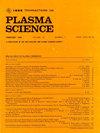An Underdetermined Single-Channel Blind-Source-Separation for Multisource Acoustic-Emission-Based Partial Discharge Signals in Power Transformers
IF 1.3
4区 物理与天体物理
Q3 PHYSICS, FLUIDS & PLASMAS
引用次数: 0
Abstract
Condition monitoring of the power transformer is important in extending the lifetime of the transformer through timely maintenance. Acoustic-emission (AE)-based partial discharge (PD) monitoring in a transformer is a commonly used technique for assessing the PD levels inside the transformer. The classification of the type of PD or localization of PD generally involves using multiple acoustic sensors, and recently, deep learning techniques have been widely used with the acquired PD data for classification. In the present work, a single-channel synchrosqueezing transform (SST)-based FastIVA blind-source-separation (BSS) technique in the time-frequency (TF) domain is proposed for the separation of multiple PD signals. SST, along with singular value decomposition (SVD), is used to identify the number of sources. The SST-FastIVA-based method is used for PD signal separation for the first time and it performs better than other separation techniques in noisy conditions. An SVM-based machine learning model is developed with original unmixed source signals for a classification task. The separated signals are tested using the developed model, and it attains an F1 score of 78.70% on the separated signals. Furthermore, the proposed methodology is used with the experimental data, and the F1 score obtained with the separated signal is 84.44%. The proposed single-channel (sensor) technique with BSS is a cost-effective method that can be used for the classification of multiple PD sources.电力变压器多源声发射局部放电信号的欠定单通道盲源分离
电力变压器的状态监测对延长变压器的使用寿命、及时检修具有重要意义。基于声发射(AE)的变压器局部放电监测是评估变压器内部局部放电水平的一种常用技术。PD类型的分类或PD的定位通常涉及到多个声学传感器,近年来,深度学习技术被广泛应用于PD数据的分类。在本工作中,提出了一种基于单通道同步压缩变换(SST)的时频(TF)域FastIVA盲源分离(BSS)技术,用于分离多个PD信号。使用SST和奇异值分解(SVD)来识别源的数量。本文首次将基于sst - fastiva的PD信号分离方法用于噪声条件下的PD信号分离,其性能优于其他分离技术。针对分类任务,提出了一种基于支持向量机的原始非混合源信号机器学习模型。利用所建立的模型对分离信号进行了测试,分离信号的F1分数达到78.70%。将该方法应用于实验数据,分离后的信号F1分数为84.44%。提出的单通道(传感器)BSS技术是一种经济有效的方法,可用于多个PD源的分类。
本文章由计算机程序翻译,如有差异,请以英文原文为准。
求助全文
约1分钟内获得全文
求助全文
来源期刊

IEEE Transactions on Plasma Science
物理-物理:流体与等离子体
CiteScore
3.00
自引率
20.00%
发文量
538
审稿时长
3.8 months
期刊介绍:
The scope covers all aspects of the theory and application of plasma science. It includes the following areas: magnetohydrodynamics; thermionics and plasma diodes; basic plasma phenomena; gaseous electronics; microwave/plasma interaction; electron, ion, and plasma sources; space plasmas; intense electron and ion beams; laser-plasma interactions; plasma diagnostics; plasma chemistry and processing; solid-state plasmas; plasma heating; plasma for controlled fusion research; high energy density plasmas; industrial/commercial applications of plasma physics; plasma waves and instabilities; and high power microwave and submillimeter wave generation.
 求助内容:
求助内容: 应助结果提醒方式:
应助结果提醒方式:


